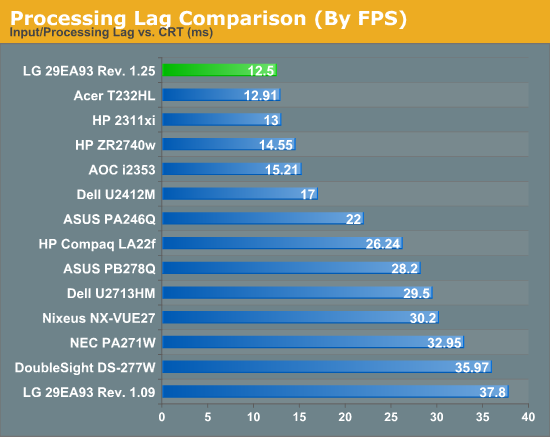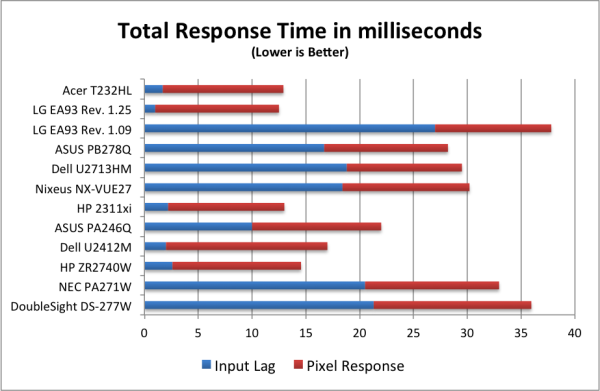LG 29EA93 Monitor Review - Rev. 1.25
by Chris Heinonen on February 12, 2013 8:49 PM ESTWith the 29EA93 being targeted towards gamers, where it can offer a wider field-of-view for games in comparison to standard 16:9 monitors, the poor lag performance of the original model was a big issue. Serious gamers would not put up with that, and so it was not connecting with its target market. With the new revision, lag is virtually non-existant. With the caveat of having to test at 1920x1080 instead of 2560x1080 due to CRT limitations, the LG exhibited 1ms of input lag with my testing. Previously we saw 27ms of input lag, so this is a completely different level of performance. Testing with the HDMI input and not the DVI input led to the same results.
Disabling the game mode only introduced another 1-2ms of lag, but at the expense of image quality, so I would leave it disabled. The total lag from input and pixel response was between 9 and 15ms. I say between because the LG 29EA93 appears to have a scanning backlight that doesn’t match-up perfectly to the refresh rate. Because of these different blanking intervals, the refresh rate of pixels can change slightly, so there is a range of response times instead of constant ones.
I also tested lag using a lag tester from Leobodnar.com, which uses an HDMI output and runs at 1080p resolution. Using a photo sensor it flashes a pattern on the screen and then senses the flash, then updates the screen to have the total lag time. Using this device I got the same results as with SMTT, between 9.6 and 15.8 ms of lag. The downside of this method is there isn’t a separate input and pixel lag time test, but it works much faster and seems to be highly accurate in my testing of it. Unless there is significant feedback about SMTT being superior to this, it might be the method I use in the future.

Due to interest, here are some screenshots showing the difference between 1920x1080 and 2560x1080 in games. I will attempt to add some more before returning the display.
Compared to the previous version, power use is 2 watts higher with both maximum and minimum backlight. That's close enough to be simple variance between units, so we won't worry about it.


















108 Comments
View All Comments
Lifted - Tuesday, February 12, 2013 - link
Just to clarify, that was all on the homepage, before clicking on the review. I only clicked on the review as the last tiny little paragraph, tucked in below the image, gave a clue that it may be worth a read. That last paragraph should go up top.inighthawki - Tuesday, February 12, 2013 - link
Same here, I almost stopped reading after about two sentences. The only reason I continued was because I believed down to earth there had to be a "but" in there somewhere, nobody could actually start a review and just say "it's bad" and be done with it :).bovinda - Tuesday, February 12, 2013 - link
I actually liked the way it was done - it set the stage well. I actually think the first few sentences do a good job of piquing one's curiosity, for exactly the reasons inighthawki stated. I wouldn't have changed it. To each their own. :)niva - Tuesday, February 12, 2013 - link
Right on, this is exactly how I felt. The title and first few words in this article almost caused me to not read thinking it was a bad product... subsequently it turned out it's actually a really good display.THizzle7XU - Tuesday, February 12, 2013 - link
Ya, the entire opening of this article made it sound like the first review was a disaster of a product. I went back to read it and it was actually a mixed, leaning positive review of the 1.09 version. And this is the much improved version.Very misleading opening...
cheinonen - Wednesday, February 13, 2013 - link
Alright, I'll get an edit in there then to make it more clear. I liked the opening, but it seems that what is clear in my head certainly didn't get communicated well once it was written.wujj123456 - Tuesday, February 12, 2013 - link
Does anyone know detailed documentations of how to perform these calibration and tests? I just searched a bit, and the CalMAN software/tool doesn't seem to be expensive. I'd love to get a hold of it so that I can calibrate my own monitors.I've been long aware that many monitors look so awful without calibration, but without a good workflow, I was just messing around until I am comfortable with what I saw...
jjj - Tuesday, February 12, 2013 - link
It's not so much about the software but the hardware , you can try to rent or find a store that calibrates screens for cheap or at the very least try the ICC profiles on TFT Central.,if they have one for your screen.cheinonen - Wednesday, February 13, 2013 - link
The PC portion of CalMAN is still in an Open Beta, which is why the uniformity numbers aren't taken from CalMAN. I can export all of the data to use, but I can't have it generate the charts for me the way that I want them yet.The real cost is hardware. As mentioned in the LG Calibration Hardware review, I'm using an i1Pro ($900 or so), a SpectraCal C6 ($700), and CalMAN ($400 or so for this package). You can get decent results with a cheaper meter, but it can also be hit-and-miss depending on the display. Most PC calibration is fairly automated, it's video displays that take a lot more work to get right.
CalMAN has a free download available I believe. It only uses a simulated meter, so you can't take actual measurements, but you could get that and then the open beta of the PC Calibration Workflow on their forums and see how it works.
kevith - Tuesday, February 12, 2013 - link
Watch out, or that's gonna be your new title...Nice review.